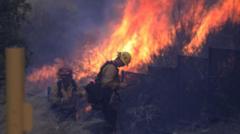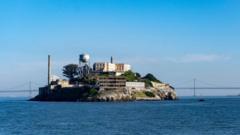A worsening situation in Southern California reflects a combination of high winds, lack of rainfall, and climate-induced shifts contributing to the state’s wildfire crisis.
High Winds and Climate Change Fuel Southern California Wildfires

High Winds and Climate Change Fuel Southern California Wildfires
Experts link drought conditions and climate change to increased wildfire risks in California.
High winds and lack of rain are the major drivers behind the wildfires currently ravaging Southern California, with climate change playing a significant role in enhancing risks, according to experts. A warming climate is linked to an uptick in "fire weather" days—periods characterized by conditions favorable for fire outbreaks. California finds itself in a precarious situation, faced with a dearth of rain following a scorching summer, which has intensified the fire threat.
The region's notorious Santa Ana winds, which can reach speeds of 60-70 mph, are sweeping down from the interior to coastal areas, creating an environment conducive to rapid and destructive fire spread. This October has witnessed the most severe wind event in over a decade. As these fierce winds dry out the vegetation, experts predict that while initial high winds enhance wildfire activity, dried-out plants will exacerbate the situation over time, prolonging the fire outbreaks.
One notable shift this season is the movement of fires from their usual mountainous habitats into the valleys, where human infrastructure is denser. "That's where there are more potential ignition sources," commented UCLA climate researcher Daniel Swain on social media. Additionally, the logistics of public safety power shut-offs present further challenges in urban areas, making firefighting efforts more complex.
California's current vulnerability is compounded by a prolonged drought that persisted until two years ago. The subsequent wet period led to vigorous growth of shrubs and trees, while last summer's extreme heat and the lack of rain—recording only 0.16 inches in downtown Los Angeles since October—have created a perfect storm for fire risks. Researchers warn that with increased average global temperatures, conditions for wildfires are becoming even more favorable, evidenced by the rising prevalence of fire weather days across various regions.
Moreover, California's unique topography poses challenges—fires are often more intense and spread faster in steep, mountainous terrains populated with combustible shrub vegetation. "While fires are a natural aspect of this region, California stands out with some of the most significant increases in the duration and severity of the fire weather season globally in recent years, primarily attributable to climate change," noted Professor Stefan Doerr, Director of the Centre for Wildfire Research at Swansea University. However, he indicated that it remains premature to pinpoint the extent to which climate change has intensified these specific wildfires, suggesting the need for thorough attribution analyses to draw firmer conclusions.
The region's notorious Santa Ana winds, which can reach speeds of 60-70 mph, are sweeping down from the interior to coastal areas, creating an environment conducive to rapid and destructive fire spread. This October has witnessed the most severe wind event in over a decade. As these fierce winds dry out the vegetation, experts predict that while initial high winds enhance wildfire activity, dried-out plants will exacerbate the situation over time, prolonging the fire outbreaks.
One notable shift this season is the movement of fires from their usual mountainous habitats into the valleys, where human infrastructure is denser. "That's where there are more potential ignition sources," commented UCLA climate researcher Daniel Swain on social media. Additionally, the logistics of public safety power shut-offs present further challenges in urban areas, making firefighting efforts more complex.
California's current vulnerability is compounded by a prolonged drought that persisted until two years ago. The subsequent wet period led to vigorous growth of shrubs and trees, while last summer's extreme heat and the lack of rain—recording only 0.16 inches in downtown Los Angeles since October—have created a perfect storm for fire risks. Researchers warn that with increased average global temperatures, conditions for wildfires are becoming even more favorable, evidenced by the rising prevalence of fire weather days across various regions.
Moreover, California's unique topography poses challenges—fires are often more intense and spread faster in steep, mountainous terrains populated with combustible shrub vegetation. "While fires are a natural aspect of this region, California stands out with some of the most significant increases in the duration and severity of the fire weather season globally in recent years, primarily attributable to climate change," noted Professor Stefan Doerr, Director of the Centre for Wildfire Research at Swansea University. However, he indicated that it remains premature to pinpoint the extent to which climate change has intensified these specific wildfires, suggesting the need for thorough attribution analyses to draw firmer conclusions.






















